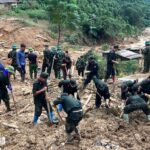The severe storm, Yagi, battered the province of Quang Ninh, leaving fish farmers like Ms. Ngo Thi Thuy with devastating losses. Thuy’s family invested in 60 fish cages, each containing approximately 500 fish, in Cam Pha and 45 cages at Ben Giang. The storm destroyed everything, and their estimated losses reached VND 12 billion.
Thuy shared that they borrowed VND 4 billion from Agribank to invest in the fish farm and now hope for loan deferment, restructuring, and new loans to recover. “If the bank trusts us and provides capital to buy and release fingerlings quickly, we can bounce back and repay the bank in just two years,” Thuy said. Many aquaculture households in Quang Yen Town also faced similar devastation, losing their boats and fish cages to the storm.
According to estimates by the State Bank of Vietnam, as of September 20, 2024, the banking system recorded approximately 83,418 customers impacted by Storm Yagi and the subsequent floods. The total affected debt amounted to nearly VND 116 trillion, representing almost 5% of the total outstanding debt in the economy.
Preliminary statistics from four commercial banks (BIDV, VCB, Agribank, and Vietinbank) revealed around 13,494 affected customers with an estimated debt balance of VND 191,457 billion. This number is expected to rise as credit institutions and State Bank branches continue to update their data in the coming days.
Mr. Dao Minh Tu, Deputy Governor of the State Bank, stated that the State Bank organized a working group to survey the two most severely affected provinces, Hai Phong City and Quang Ninh Province, immediately after the storm. He emphasized the need for stronger support policies for those who suffered significant losses, as many seafood farmers invested tens of billions of dong and were left with little to show for it.
TIMELY INTEREST RATE REDUCTIONS FOR BORROWERS
Prior to this, the State Bank instructed commercial banks to reduce interest rates for customers affected by Storm Yagi, taking into account the actual situation.
“Whenever a significant force majeure event occurs, such as natural disasters or epidemics, the banking industry is always ready to share difficulties with people and businesses,” said Mr. Nguyen Quoc Hung, Vice Chairman and General Secretary of the Vietnam Banks Association (VNBA).
Mr. Hung added that following the storm, commercial banks, in collaboration with insurance companies, promptly visited the affected areas to assess the damage and develop support plans for their customers. From September 12, 2024, onwards, most banks have implemented solutions to waive or reduce interest rates for customers impacted by the storm and floods. Many banks offered interest rate reductions of 0.5-2% for individuals and households borrowing capital who suffered losses due to Storm No. 3. This support period ranges from September 2024 to December 2024, with some banks extending it to January 2025.
Currently, the average lending rate of banks ranges from 6.3-7.8%. With the interest rate reduction of 0.5-2%, people and businesses affected by Storm Yagi will have the resources to recover their production and business activities and, subsequently, repay the banks.
However, Mr. Hung mentioned that Storm Yagi and its aftermath have slowed down the circulation of hundreds of trillions of dong in the banking system, hindering the creation of added value. As a result, banks also face certain challenges in maintaining liquidity, despite not suffering significant physical infrastructure damage.

Regarding this issue, Deputy Governor Dao Minh Tu assured that the State Bank would implement mechanisms to enable commercial banks to mobilize social resources, flexibly manage tools within the scope of the State Bank’s authority to ensure liquidity for the system, and support banks in having sufficient resources to continue lending to key sectors and projects.
ALLOWING DEBT MORATORIUM IN SPECIAL CASES
On the policy of restructuring repayment periods and maintaining the debt group for customers affected by Storm No. 3, Mr. Nguyen Quoc Hung stated that while this is necessary, in the long run, the Government and the State Bank need to consider designing a debt moratorium policy for customers severely affected by natural disasters and epidemics.
According to the Vice Chairman of VNBA, the potential non-performing loans from the restructured debt balance have not yet been clearly reflected, presenting challenges to banks regarding asset quality in the coming years.
Post-storm, the asset quality of banks has been significantly impacted, even with loan insurance. The infrastructure of hotels, restaurants, cruise ships, fishing vessels, and aquaculture and fisheries facilities has been washed away by the storm and floods. Additionally, cattle and buffalo have also perished.
Consumer credit has also taken a hit. During the challenging COVID-19 period, when incomes were reduced and jobs lost, borrowers wanted to repay their debts but lacked the financial means to do so.
“The high non-performing loan ratio has made consumer finance companies reluctant to lend anymore,” Mr. Hung shared. He also noted that these factors, combined with the increasing difficulty of handling bad debts, expose credit institutions to significant risks.

Having gone through the COVID-19 crisis, from 2020 until now, the risk provisions of Vietnamese commercial banks have continuously declined, and the risk buffer is now very thin. Without substantial support from the Government, the safety ratios exceeding international standards will create many potential risks for banks. In essence, banks are businesses that operate with the money and trust of depositors. Their safety is crucial for macroeconomic stability and the country’s reputation.
Therefore, the Vice Chairman of the Vietnam Banks Association proposed that in this natural disaster, the Government should implement a mechanism to allow banks to freeze debts for severely affected customers who need more time to recover, instead of restructuring the repayment period and maintaining the debt group as before.
Attorney Truong Thanh Duc, Director of ANVI Law Firm, suggested that debt freezing is a good solution in the current context, helping banks have conditions to lend to customers severely damaged by Storm No. 3 and reducing risks for the system.
According to experts, in reality, the debts that have been restructured in terms of repayment period since 2020 have increased non-interest-bearing assets, which means reducing profits and increasing bad debt risks for banks.
Experts said that the nature of debt freezing is to allow enterprises to temporarily stop repaying principal or interest within a certain period. In the context of the pandemic and natural disasters over the past five years, banks and enterprises need to freeze debts with due debts and potential bad debts.
However, Mr. Duc said that there is currently a lack of legal basis for debt freezing. Laws, decrees, and circulars do not stipulate this, except for a few special cases such as investment projects in the public sector or some policy loans. On the other hand, consumer loans and production and business loans have not had the concept of debt freezing for 24-25 years.
While acknowledging that debt freezing is a suitable solution in the event of a severe disaster, experts also acknowledged that it is not simple and is even very difficult because it involves the budget. To implement the debt freezing policy, the Government must have the budget to repay the debt on behalf of the enterprise if, at the end of the debt freezing period, the enterprise still cannot repay the debt…
https://postenp.phaha.vn/chi-tiet-toa-soan/tap-chi-kinh-te-viet-nam

What Happens If You Don’t Donate to Support Flood Victims?
“Authorities have warned that organizations and individuals who solicit and receive donations for flood and storm relief but divert these funds from their intended purpose may face legal consequences, including criminal charges or administrative penalties.”


















